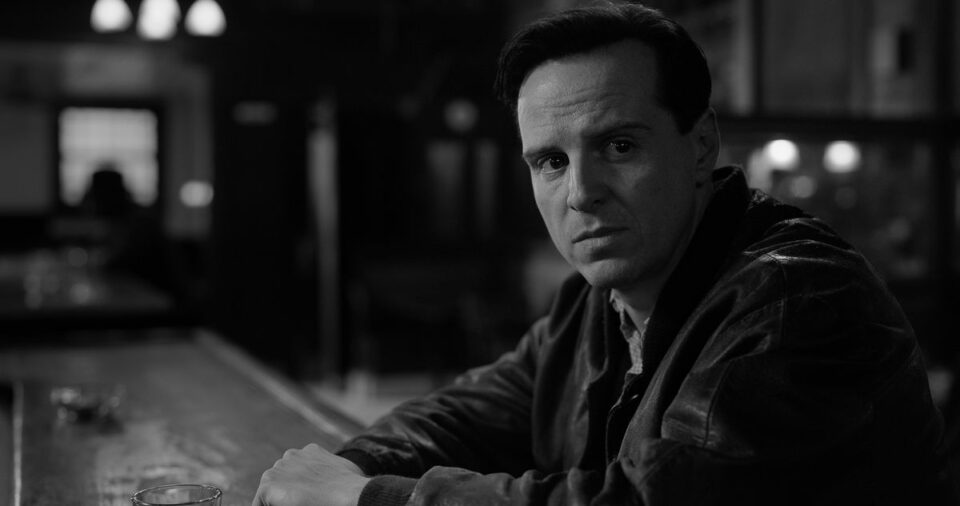
As far as grifters go, Tom Ripley is unorthodox. He is smart but awkward, careful but clumsy. He is all-American-boyish, broad-shouldered, and clean-shaven, handsome in a commonplace way. He is less of a calculator and more of an opportunist, a rare kind of lucky scammer to whom the right things just happen. Opportunities fall into his lap like little presents. Because life is so bountiful, he is also bratty: It’s annoying to him that committing crimes comes with all kinds of logistical problems, like where to hide a body or where to send a piece of mail. Tom Ripley scams because he wants his life to be easy, not hard. He meets procedural issues with the whining annoyance of a kid who had just turned the TV on when his mom made him get up to take the dog out.
That determination makes Tom a true grifter. If he knows what he doesn’t want, he also knows full well what he does want, down to the last detail. He knows what he wants to look like and how he wants to be perceived, which gives him a demented kind of confidence. Confidence, of course, is key to swagger — which goes a long way toward explaining Tom’s enduring appeal. He was first introduced to the world as the protagonist of Patricia Highsmith’s best-selling 1955 novel The Talented Mr. Ripley, the first of a series of five books that ended with Ripley Under Water in 1991. Since then, Ripley’s story has been frequently adapted to the screen, attracting heartthrobs of all spades to play the titular part. Alain Delon played Tom in 1960’s Purple Noon, as did Matt Damon in 1999’s The Talented Mr. Ripley. Older versions of him included John Malkovich’s turn in Ripley’s Game in 2002 and Dennis Hopper in 1977’s The American Friend. With Ripley, Netflix’s series adaptation of the original 1955 novel, the Irish actor Andrew Scott — known, loved, and never forgotten as Fleabag’s Hot Priest — has taken up the task. Wearing a slouchy leather jacket and puppy eyes, Scott’s Tom is a bit older than expected, but what he lacks in youth he makes up for in a weathered look that perfectly merges paranoia, confusion, and melancholy. You feel bad for him while also having to admit he gives you the creeps.
Ripley, which is directed by Steve Zaillian (writer of an impressive number of successful screenplays, from The Girl With the Dragon Tattoo to Schindler’s List), is shot in a silky black-and-white. It opens in Rome in 1961 as Tom drags a dead body down a set of stairs. This is only the first out of an interminable number of stairs that Tom will have to deal with throughout the episode. They abound in Atrani, a village on the Italian Amalfi Coast where, six months earlier, Tom ends up at the request of Mr. Herbert Greenleaf, a shipyard magnate who approaches him through a private investigator. The P.I. is necessary because Tom is notoriously hard to find: Holed up in a consummate Manhattan shitty apartment, Tom spends his days pretending to be George McAlpin, a debt collector who pesters old ladies fond of chiropractors for made-up outstanding balances. At first, Tom doesn’t think much of the private investigator or of Mr. Greenleaf, whose name he doesn’t recognize. But the IRS is on his tail, so he finally decides to give Mr. Greenleaf a call.
It’s here that Tom’s lucky grift starts to emerge. Under the impression that Tom is good friends with his son, Dickie Greenleaf, a trust-fund dilettante who has decided to live in Italy to paint and dillydally instead of working with his father as planned, Mr. Greenleaf offers Tom money to go to Italy and convince the playboy to come home. Over dinner at the Greenleafs, Tom eats oysters and looks at baby photos of Dickie. Zaillian pays clever attention to the textural details of the Greenleafs’ swanky apartment: The surfaces are silver and shiny, the oyster meat luscious, the collars of the Brooks Brothers shirts that Mrs. Greenleaf has Tom take for Dickie starched and crisp. Against this opulence, the very thought of the anemic water pressure in Tom’s communal shower is enough to make a person’s skin crawl. Besides, Tom likes the Greenleafs: They are luxurious without being ostentatious, entitled without being presumptuous. In a departure from other, more affected depictions of Mr. Greenleaf, Zaillian opts to have him transmit paternal earnestness. It works like magic on Tom, whose own parents, he tells the Greenleafs, died in a boating accident when he was a kid.
This is the thing about Tom: He lies left and right — he tells Mr. Greenleaf he works in insurance — but he cuts his deceptions with just enough truth to infuse his schemes with real connection and, therefore, personal stakes. Tom did grow up an orphan, under the care of his garish Aunt Dottie. (As he writes to her from the train that he won’t need her “little checks” anymore, now that he’s had a “business opportunity” present itself in Europe, he imagines she is undergoing a painful dental operation; an apt testament of his affection for her.) But he didn’t really know Dickie, though he lets Mr. Greenleaf believe he did. It’s not a lie per se, more like an obfuscation of truth. Before embarking on his transatlantic journey — due to his parents’ death, Tom is made uneasy by water, a major motif of his story — he stops by Brooks Brothers to pick up Mrs. Greenleaf’s order for her son. She had forgotten to pick out a bathrobe for Dickie, so Tom takes it upon himself to choose one. He looks satisfied with a truly horrendous paisley robe in “maroon,” which the sales associate not-so-kindly points out is burgundy.
As soon as Tom makes it to Atrani, after a long and confusing journey from Naples, the problem with the stairs begins. He asks Matteo, the sweet local post office man, where he can find Dickie. “Su, su,” he says with an upward motion of the hand, as in, “up, up.” Tom dutifully climbs up the stairs that snake up the mountainous town. When he gets to Dickie’s villa, a palatial summit that looks out onto the Mediterranean, the housekeeper Ermelinda tells him that Dickie is on the beach, which is, of course, all the way down. He stops by a store to buy a bathing suit, though all they have is a teeny-tiny-speedo number that frankly looks ridiculous, especially when paired with the dress shoes that are Tom’s only footwear option — they make him look inadequate and exposed. He finally finds Dickie at the beach, sunning himself with Marge, her head resting on his stomach. Dickie and Marge have most memorably been played by Jude Law and Gwyneth Paltrow in Anthony Minghella’s The Talented Mr. Ripley, two-thirds of a trio that, completed by a late-’90s Matt Damon, is rivaled only by the ’60s French psychosexual drama La Piscine (starring Alain Delon, Romy Schneider, and Jane Birkin) in astronomical levels of horniness and sexiness. By comparison, Johnny Flynn and Dakota Fanning’s Dickie and Marge are less openly sex magnets. They are coarser, less blonde. Where Law and Paltrow are sinewy and bubbly, Flynn and Fanning are rugged, close-faced. Dickie doesn’t really remember Tom but invites him up for lunch anyway. Back up the stairs they go.
Lunch is really awkward. Tom is heaving from the effort of climbing up the stairs, not to mention still embarrassed by his bathing suit. Down by the water, he hadn’t swum out with Dickie and Marge, which means he was just kind of standing around and waiting for these two strangers to come out to have the stiffest, most boring conversation of all time. The whole encounter has the distinct flavor of an interaction no one involved wants to participate in. Tom leaves kind of resigned. Dickie had told him that the best hotel in town was the Miramare, so when Tom goes to get his bags from the post office, where he had left them, he asks Matteo where the hotel is. Up the stairs Ripley goes again.
The bit with the stairs is slapstick funny, but it also provides an unexpected entry into the unique tone Zaillian has set for his adaptation. Atrani’s stairs, which feature a middle landing decorated with an altar for the Virgin Mary, feel unending and enclosed, claustrophobic in their inevitability. They also give the director plenty of sharp angles to work with, creating the distinct feeling that a watchful presence is just around the corner, occupying the blind spot that you’re trying to avoid. Tom’s suspicion has him constantly looking over his shoulder, and Zaillian’s use of the stairs is a clever solution to the problem of how to establish his interior uneasiness, which, so far, is a bit unfounded. After all, up to this point, Tom has lied, but not gravely or excessively — his traceable wrongdoings, which accumulated to a series of checks made out to George McAlpin, were all burned in a trash can back on his fire escape in Manhattan. The prospect of wrongdoing, the possibility of it, trails Tom. It’s too easy to fool these people.
The stairs’ right angles combine with the black-and-white and the appearance of a P.I. in the first ten minutes of “A Hard Man to Find” give Ripley a noir feel, which is a fresh approach to a story that has often been shot in sun-blown tones. That sunniness is not incidental; it’s part of what makes Dickie, Marge, and Atrani so attractive, which makes us understand why Tom might feel moved to intercept their lives — thereby surreptitiously making us sympathize with him. Zaillian’s coldness blocks some of the story’s sense of bewitched enrapture; his self-serious tone is out of sync with the frivolity that characterizes life in Atrani, and keeps the audience at arm’s length. But then again, the moodiness tells us that shit will hit the fan, and imminently. Before leaving Dickie’s house after lunch, Tom swipes a fountain pen from his desk. When he gets back to the Miramare, he looks into his reflection in the mirror and introduces himself: “Hi, I’m Dickie Greenleaf.” As a harbinger of worse things to come, this moment, as the episode at large, firmly establishes the fundamental truth of the whole Ripley enterprise: It’s a slippery slope. An opportunity has presented itself to Tom, whose style of grifting we’re just coming to know.
By Rafaela Bassili , 2024-04-04 10:00:21
Source link


